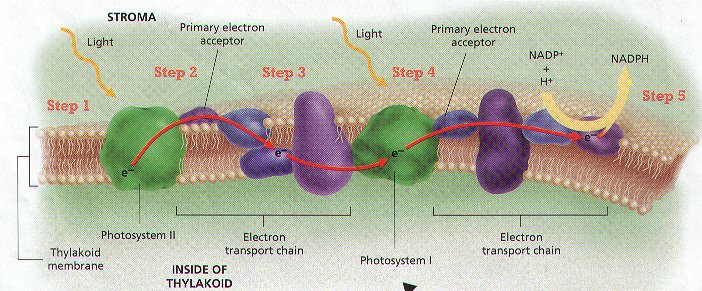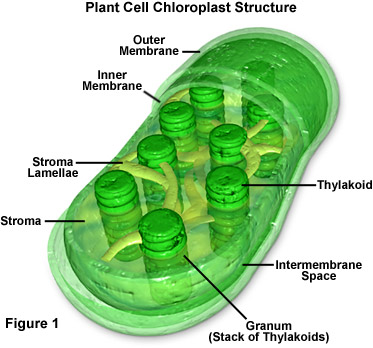In plant cells, chloroplasts capture light energy from the sun and convert it to chemical energy that can be stored in sugars and other organic compounds. This process is called photosynthesis.
- Stroma = Matrix
Chloroplast are plant cell organelles that are mostly located in the cells that make up the Mesophyll tissue, which is part of the plant's leaf. The exterior of the lower epidermis of the leaf cell contains many tiny pore called stomata, through which carbon dioxide can enter and oxygen can exit the leaf.
Mesophyll Stomata
Stomata
Chorolplasts have an outer membrane and an inner membrane. Inside the inner membrane is the stroma, which is a dense fluid filled area. Within the stroma (matrix) is a vast network of innerconnected thylakoid membranes, inside which lies the thylakoid space (space between the thylakoids).
Chlorophyll is located in the thylakoid membranes and is the light-absorbing pigment that drives photosynthesis and gives plants their green color.
Chloroplast Analogy
Granum = Stack of pancakes
Thylakoid = Individual pancake
Stroma = Syrup
6CO2 + 12H2O + Light energy --> C6H12O6 + 6O2 + 6H2O
Plants can produce organic compounds and oxygen (O2) using light energy, carbon dioxide (CO2), and water (H2O). The 2 main parts of photosnythesis are:
- Light reaction
- Calvin cycle
In the light reactions of photosynthesis, solar energy is converted to chemical energy. Light is absorbed by chlorophyll and drives the transfer of electrons from water to NADP+ (to create NADPH), which stores them. Water is split during the course of these reactions, and O2 is given off. The light reactions also produce ATP from ADP in photophosorylation. The net products of the light reactions are NADH (which stores electrons), ATP and Oxygen.

In the Calvin cycle, CO2 from the air is incorporated into organic molecules in carbon fixation. The fixed carbon is then used to make carbohydrates. NADPH is used to power carbon fixation. The Calvin cycle also uses ATP in the course of its reactions.
Differences between Cellular Respirations and Photosynthesis
Cellular Respiration Photosynthesis
3 main parts of whole cycle 2 main parts of cycle
- Glycolosis - Light Reaction
- Krebs Cycle - Calvin Cycle
- Chemisomoses
C6H12O6 (oxidized) + O2--> H2O + CO2 H2O + CO2 --> C6H12O6 (Reduced) + O2
Catabolic (break down) Anabolic (build up)
- release ATP - produced ATP
NAD+ oxidized --> NADH NADP+ reduce --> NADPH
- reduced charge
Mitochondria Chloroplast
Glycolysis & Krebs Light Reaction
- build ATP - release ATP
ETC Calvin cycle
- release ATP - break down ATP
- synthesis glucose
Eukaryotes Plants
Created by Alyssa Hamilton

No comments:
Post a Comment